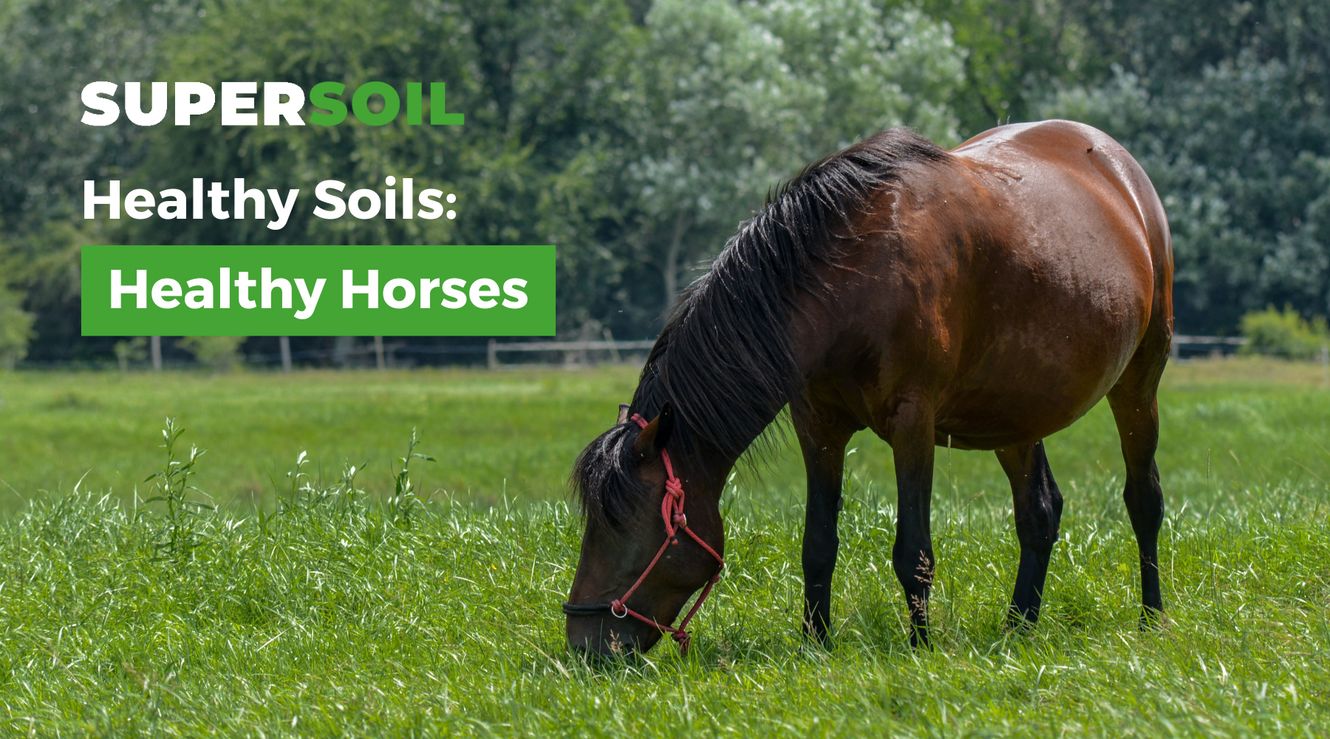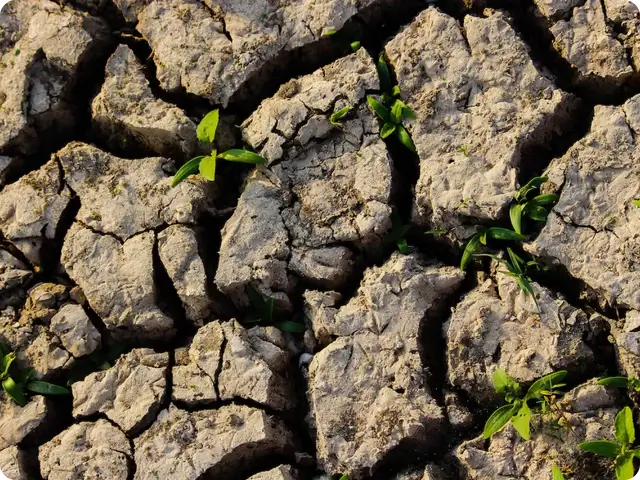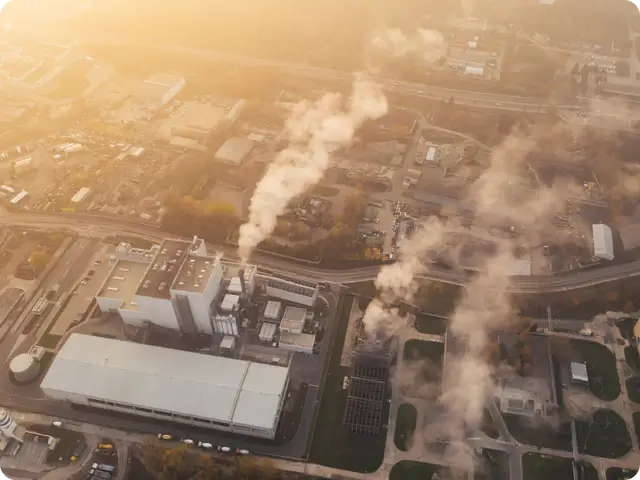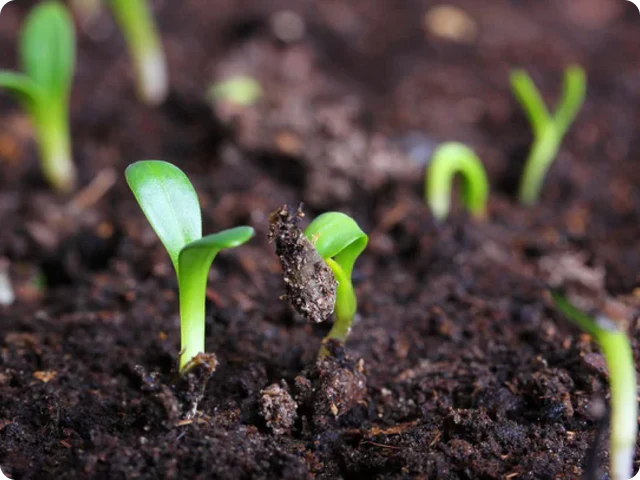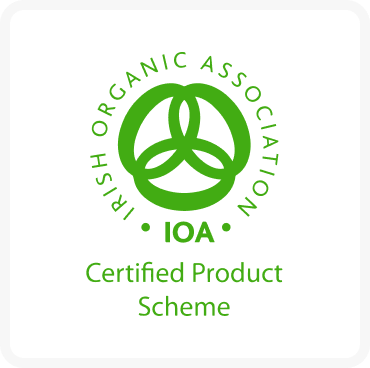How Nurturing Your Soil Can Nurture Your Horses
Like people, horses also appear to be getting sicker, and no one knows why. There are countless cases of neurological disorders, digestive diseases, and things like Equine Grass Sickness with no known cause other than they all ate grass. There are also widespread bacterial, viral, and protozoan infections, including African Horse Sickness, a viral condition spread by biting midges with extremely high mortality rates. Numerous zoonotic diseases also spread between humans and horses, with individuals of both species with poor immune systems being the most susceptible. There is even a re-emergence of old infectious diseases that largely disappeared with the arrival of antimicrobial drugs but are on the rise and linked to impaired immune systems.
Curiously, many of those illnesses either suspiciously mimic pesticide poisoning or result from impaired immune systems, yet few are making the connection. All those horses have one thing in common: they eat grass and hay, almost entirely grown by so-called ‘conventional’ means. We are getting ill from our modern diets because we are what we eat, and horses are what they eat—garbage in means garbage out.
The Problem With Conventionally Grown Grass
Conventional farming is actually new farming, so it is contemporary, not conventional, since it only became widespread in the 1940s. Perhaps it is better called chemical farming since it relies entirely on synthetic nitrogen and other chemical inputs to achieve yields.
A huge problem with using agrochemicals is that it destroys the natural nutrient cycling of the soils, which makes the products grown on them increasingly dependent on larger and larger inputs of agrochemicals to achieve the same yields. For example, while cereal production tripled in the past 40 years, synthetic nitrogen use increased almost ten times. During that time, soil nitrogen also declined substantially since it is almost entirely found in organic form in our soils. This means that while synthetic fertilisers may provide yields in the short term, they create a long-term chemical dependency that is unhealthy for everything and benefits no one but the fossil fuel and agrochemical industries.
Pesticide use has also increased by 81% since 1991, despite countless medical and scientific studies showing the dangers of consuming pesticides with our foods. Furthermore, studies have shown that pests in pesticide-treated conventional fields can be up to ten times greater than in regeneratively farmed fields. So, why are we poisoning our fields, and by extension, ourselves and our horses, when they do not even work in the long term?
The Alarming Decline of Nutrients in Chemically Grown Food
Another concern with conventional agriculture is the alarming nutrient decline in crops grown with chemicals. Horses are no different than people or plants; we all need basic nutrients to grow and thrive. We need macronutrients in large quantities, micronutrients in small quantities, and trace nutrients in tiny amounts to be healthy. Synthetic N-P-K fertilisers provide none of those.
While we lack direct studies on hay and grass, we can draw parallels from studies in human foods. Those studies show that while crop yield and per-capita food availability have increased since the 1940s, so has malnutrition, as people are overfed but undernourished by poor-quality diets.
Countless peer-reviewed scientific studies worldwide have documented alarming declines in the nutrient content of various agrochemical crops, summarised in the table below. The ranges in numbers represent variations in soil conditions, the length of time the studies covered, and different food crops that vary significantly in nutrient content.
Table: Summary of Nutrient Declines in Conventional Crops in The Last 50-70 Years
|
Nutrient |
% Decline Since Conventional Agriculture |
|
Calcium |
16 - 65% |
|
Magnesium |
7 - 35% |
|
Potassium |
6 - 20% |
|
Sodium |
29 - 49% |
|
Iron |
15 - 95% |
|
Copper |
20 - 81% |
|
Phosphorus |
6 - 52.4% |
|
Zinc |
27 - 59% |
|
Vitamin A |
18 - 68.3% |
|
Riboflavin |
38% |
|
Vitamin C |
15 - 29.9% |
In all cases, nutrient levels have experienced severe declines. A few studies (not disclosing their funding source) have tried to discredit the results obtained by so many scientists by pointing to the “nutrient dilution effect,” which says that yields have gone up, so nutrient concentration has declined. Even if that could account for some of the decline, is that really a positive argument for chemical agriculture? After all, what is the point of eating food that doesn’t provide us with the basic elements necessary for good health? On the other hand, no study, scientific or otherwise, showed that nutritional value has increased with all of our advances in “conventional” agriculture.
So, if nutrients have declined so dramatically in our crops, it is safe to say that conventionally grown grass and hay have done the same.
What is the Cause of Nutrient Decline?
Peer-reviewed studies all point to soil degradation, resulting in poor nutrient availability as the primary cause of decline. Additional factors like high-yield varieties (the nutrient dilution argument), agrochemicals, genetically modified organisms, a thinning ozone layer, and elevated carbon dioxide in our air also play significant roles.
Since chemical farming focuses almost entirely on yields, it results in a systematic nutrient decline in the nutrient dilution effect. However, it also causes soil degradation, soil pollution, water pollution, air pollution, and climate change, which all worsen nutrient decline in a destructive feedback cycle.
Garbage In - Garbage Out
The old saying “you are what you eat” has great truth. Plants are no different from people or horses. Grass grown with chemicals contains chemicals; it is that simple. When the horses eat the grass, they eat the chemicals the plants take in. Those chemicals also leach into the water, where they ingest it again. Then, chemical residues are left on the grass and hay, which they consume directly. Everything they eat or drink, therefore, contains synthetic chemicals.
Would you expect to have a healthy horse if you fed it a handful of synthetic fertiliser or pesticides? We would never do that and for good reason. Yet we expect horses to be healthy when we feed them grass and hay grown with those same fertilisers and pesticides. Why is that? It is because it’s considered ‘conventional’ and therefore safe when nothing could be further from the truth.
A new campaign by the agrochemical industry in response to the growing threats of environmental degradation and global food security is the 4 Rs: “Right fertiliser, right rate, right time, right place.” However, that still demands a dependency on agrochemicals. One of the most alarming things about that campaign is their promotion of more slow-release fertilisers as a “sustainable solution.” The problem is that those slow-release products are coated in plastic polymers, causing more problems than they solve.
The Dangers of Microplastics
Many people have now heard of microplastics from the breakdown of plastics as they physically degrade in our environment, filling our oceans, freshwater, soils, and plants. If that isn’t concerning enough, microplastics have even been found in the blood of human fetuses.
However, very few know of the intentional widespread use of microplastics in agrochemicals like fertilisers and pesticides. It is one of the most easily preventable forms of microplastic pollution, yet it is on the rise. These intentionally added microplastics accounted for nearly half of the microplastics used in the European Economic Area in 2019. In 2021, the UN Foods and Agricultural Organization estimated that fertiliser coatings accounted for about 100,000 tonnes of plastics used in agriculture around the globe every single year.
While the reports of microplastics in our waters are very concerning, the microplastics in our terrestrial soils are 4-23 times greater than in marine environments, and they are mostly added on purpose, not from the degradation of improperly disposed plastics. Yet, thanks to funding from the agrochemical industry promoting their use in “sustainable farming,” few are paying attention to this pervasive global threat.
Microplastics in our pastures and hay fields are dangerous because, just like fertilisers and pesticides, they are taken up by plants and then, in turn, by our horses. They also leach into the water supply, where, again, they are ingested by our horses. Finally, when the horses eat grass or hay with residual fertilisers and pesticides, they also consume the plastics directly, giving them a triple serving of plastic with every meal, seasoned with chemical fertilisers and poisonous pesticides.
Chemicals are Making Our Horses Sick
Curiously, synthetic N-P-K fertilisers can act as a pesticide. For example, studies showed that when used at the recommended level for plant growth, it significantly reduces larval survival in Haemonchus contortus, a gastrointestinal parasitic nematode mostly prevalent in sheep. The study implied that synthetic N-P-K was beneficial, and sadly, many readers would think the same since it kills a common parasite. But if you understood that garbage in equals garbage out, the results of that study should be alarming, not encouraging. Fertilisers are supposedly used to promote healthy plant growth, not kill things. Isn’t that what pesticides are for?
Synthetic pesticides are even worse. We already know that pesticide exposure causes cancer, immunological and reproductive harm, and neurological diseases in humans when we are exposed to or consume them. Astonishingly, as many as 44% of farmers also suffer from unintentional acute pesticide poisoning yearly yet continue to use them. Countless studies have also shown that pesticide poisoning in horses from inappropriate use, handling, or storage or accidental ingestion causes chronic wasting, skin lesions, numerous nervous system disorders, digestive damage, seizures, and a combination of symptoms called ‘SLUD’ that include excess salivation/sweating, lacrimation, urination, and defecation. If accidental ingestion of larger amounts causes serious harm and even death, why wouldn’t daily ingestion of smaller amounts? Despite the lack of studies to prove it, common sense says it does.
The dangers of microplastics are just beginning to surface. Not only do they present physical and chemical hazards in the body from the substances already within them, but scientists have also shown that microplastics absorb external toxins and release them when ingested. So, they also become a dangerous source of persistent organic pollutants, heavy metals, and other dangerous forever chemicals in the body.
Many studies have recently been done on the effects of microplastics on animals. Lab experiments found they induced disorders in rats and mice in their intestines, livers, and excretory and reproductive systems. Other studies showed short-term exposure induced behavioural changes and alterations in immune markers in their liver and brain tissues. While there is currently a lack of studies directly on horses, those lab experiments easily suggest that they harm our horses similarly.
Apart from the obvious dangers of directly eating chemical fertilisers and pesticides in plants and as residues on the plants, they also damage the soil microbes and mycorrhizal fungi that provide nutrients and enhance their uptake. Soil is not just minerals; by definition, it contains organic matter and organisms. But look at the soil in a hayfield grown with agrochemicals and compare that to one that is regeneratively grown. The chemical fields’ soils are pale and devoid of life; the minerals don’t stick together, and they erode away. It doesn’t even contain death in the form of organic matter and humus that nourish our plants; it is just minerals. As a result, the plants that grow in them are dependent on a chemical ‘fix’ not unlike a drug addict; they are weak with damaged immune systems and temporarily propped up by the chemical fixes that they require in increasingly larger doses as the soil becomes more depleted by their presence. Then, we harvest that unhealthy, chemically dependent hay and feed it to our horses.
The problem with all these synthetic chemicals is that the only microbes that can survive their onslaught are extremophiles that thrive in extreme environments. Your horse’s gut is supposed to have a healthy balance of natural microbes. Yet, chemicals kill those healthy microbes, creating an imbalance and leading to overpopulations of extremophiles. This is followed by countless digestive, neurological, and reproductive conditions and other diseases. Instead of recognising the source of the problem - our mineral soil devoid of life and plants filled with chemicals - we are taught to resort to more chemicals to correct it in the form of various antibiotics and other medicines. While those medicines may be necessary in the short term to help your horse overcome an illness, they are clearly not a viable long-term solution.
But the problems don’t even end there. Nutrient deficiencies also make horses weak and more prone to diseases. Micronutrient deficiencies are well-studied in humans and are known to cause a wide range of chronic health problems, including stunted growth, impaired cognitive development, weakened immune systems, increased risk of infections and chronic diseases, and blindness. Grass and hay grown with N-P-K have poor micronutrient contents; therefore, it is safe to assume similar things are happening in our horses.
Horses are exceptionally brilliant and highly social animals. Most owners feel that their horses can feel and express pain, fear, jealousy, sadness, anxiety, and boredom; they have the same feelings that we do. Synthetic chemicals and microplastics wreak havoc with your horse's digestive, neurological, and immune systems. They get sick, don’t thrive, are lethargic, and don’t perform at their best. Not only will this cause veterinary bills to skyrocket, but having to watch our horses suffer in pain is like having to watch our friends or family suffer the same.
How Healthy Soils Make Healthy Grass and Healthy Horses
So, now that we have learned all the damage that conventional agriculture does to our horses, it's time for a positive, easy, fast, and cheap solution—far cheaper, in fact—than conventional agriculture. The answer is simple: stop killing your soil with chemicals and turning it into lifeless and deathless minerals filled with toxins.
When we nurture our soil with regenerative agriculture and add soil microbes to rebuild our soil biome, we create healthy soil full of humus made from the waste of microbes, root exudates, and other organics. When we have thriving soil microbes, we also have soil filled with dead microbes called microbial necromass. Studies have found that microbial necromass accounts for about 50-80% of our organic soil carbon and about 41-92% of our soil nitrogen stores, providing enormous nutritional benefits. A healthy soil microbiome also creates better micro and trace nutrient availability that is completely lacking in chemical agriculture. Better micronutrient availability also promotes higher microbial diversity in a self-perpetuating cycle of healthy soil, healthy microbes, healthy plants, and healthy horses.
Science shows that a healthy soil microbe population creates plants with a better immune system to naturally fight off pests and diseases. Thus, they no longer need chemical fixes from synthetic fertilisers and pesticides. Those healthier plants also produce far more healthy phytochemicals—plant-produced organic chemicals. While phytochemicals are not traditionally considered when talking about nutrition, multiple studies have shown that in humans, they can reduce inflammation and significantly boost health. It is likely they do the same for our horses.
Finally, try listening to your horse. When given the choice of regeneratively farmed grass, hay, and haylage over chemically grown foods, they will choose the regenerative grass nourished with soil microbes instead of that grown with chemicals. Your horse may already know what the rest of us are just starting to figure out: healthy plants keep us all healthy.
How Do We Make Healthy Soil?
Making healthy soil is simple, incredibly cheap, and easily adaptable on any scale. All you need is organic matter and microbes. Stop feeding grass and hay chemicals to ‘nourish’ them. Instead, compost and manure are added back to the soil before planting, naturally replenishing the nutrients.
Also, since chemicals destroy the soil microbiome, we must add healthy microbes back to the hay fields and pastures to recreate a healthy microbe population. We need a healthy soil microbiome since the microbes perform the magic in regenerative farming, creating healthy plants.
When our plants become healthy, we wean them off their chemical addiction. Regeneratively farmed hayfields and pastures produce abundant grass and hay using only compost, manure, and microbes. No more lining the pockets of rich chemical companies so you can give whatever money you have left to your veterinarian in an attempt to keep your horses healthy.
When our grass and hay are healthy and nutrient-rich, our horses are too. Instead of garbage in - garbage out, we now have health in - health out.
References Used:
Bender, J. B., & Tsukayama, D. T. (2004). Horses and the risk of zoonotic infections. The Veterinary Clinics of North America. Equine Practice, 20(3), 643-653. https://doi.org/10.1016/j.cveq.2004.07.003
Bhardwaj, R. L., Parashar, A., Parewa, H. P., & Vyas, L. (2024). An Alarming Decline in the Nutritional Quality of Foods: The Biggest Challenge for Future Generations’ Health. Foods, 13(6), 877. https://doi.org/10.3390/foods13060877
Boedeker, W., Watts, M., Clausing, P. et al. The global distribution of acute unintentional pesticide poisoning: estimations based on a systematic review. BMC Public Health 20, 1875 (2020). https://doi.org/10.1186/s12889-020-09939-0
Carlinia, Guilia, Dana Drugmand, and David Azoulay (2022). SOWING A PLASTIC PLANET
How Microplastics in Agrochemicals Are Affecting Our Soils, Our Food, and Our Future. Center for International Environmental Law. https://www.ciel.org/wp-content/uploads/2022/12/Sowing-a-Plastic-Planet_1dec22.pdf
Daniela Bedenice, Amy L Johnson, Neurologic conditions in the sport horse, Animal Frontiers, Volume 12, Issue 3, June 2022, Pages 37–44, https://doi.org/10.1093/af/vfac036
Drugmand, Dana, Steven Feit, Lili Fuhr, and Carroll Muffett. (2022). Fossils, Fertilizers, and False Solutions - How Laundering Fossil Fuels in Agrochemicals Puts the Climate and the Planet at Risk. Center for International Environmental Law. https://www.ciel.org/reports/fossil-fertilizers/
ECHA, Annex XV Restriction Report – Microplastics, 74 (Table 15). The European Economic Area includes the Member States of the EU as well as Norway, Iceland, and Liechtenstein.
Food and Agriculture Organization, Assessment of Agricultural Plastics and Their Sustainability: A Call for Action (Rome: FAO, 2021), 22 (Figure 10), https://doi.org/10.4060/cb7856en.
Gaspar, L., Bartman, S., Coppotelli, G., & Ross, J. M. (2023). Acute Exposure to Microplastics Induced Changes in Behavior and Inflammation in Young and Old Mice. International Journal of Molecular Sciences, 24(15). https://doi.org/10.3390/ijms241512308
Hargreaves-Méndez, M. J., & Hötzel, M. J. (2023). A systematic review on whether regenerative agriculture improves animal welfare: A qualitative analysis with a One Welfare perspective. Animal Welfare, 32. https://doi.org/10.1017/awf.2023.28
Hepperly, P., Lotter, D., Ulsh, C. Z., Seidel, R., & Reider, C. (2009). Compost, Manure and Synthetic Fertilizer Influences Crop Yields, Soil Properties, Nitrate Leaching and Crop Nutrient Content. Compost Science & Utilization, 17(2), 117–126. https://doi.org/10.1080/1065657x.2009.10702410
Hötzel, M. J., Vieira, M. C., & Leme, D. P. (2019). Exploring horse owners' and caretakers' perceptions of emotions and associated behaviors in horses. Journal of Veterinary Behavior, 29, 18-24. https://doi.org/10.1016/j.jveb.2018.10.002
Joanna, Gorsich, E. E., Grewar, J. D., Atkins, B. D., Warren, Karien Labuschagne, & Tildesley, M. J. (2023). Modelling African horse sickness emergence and transmission in the South African control area using a deterministic metapopulation approach. PLOS Computational Biology/PLoS Computational Biology, 19(9), e1011448–e1011448. https://doi.org/10.1371/journal.pcbi.1011448
Laus, F., Corsalini, J., Mandara, M.T. et al. Equine grass sickness in italy: a case series study. BMC Vet Res 17, 264 (2021). https://doi.org/10.1186/s12917-021-02966-y
Liu, Yuan, Jing Tian, Nianpeng He, Lisa Tiemann (2021). Global microbial necromass contribution to soil organic matter. Www.researchsquare.com. https://www.researchsquare.com/article/rs-473688/v1
Lönker, N. S., Fechner, K., & El Wahed, A. A. (2020). Horses as a Crucial Part of One Health. Veterinary Sciences, 7(1). https://doi.org/10.3390/vetsci7010028
Montgomery, D. R., Biklé, A., Archuleta, R., Brown, P., & Jordan, J. (2022). Soil health and nutrient density: Preliminary comparison of regenerative and conventional farming. PeerJ, 10. https://doi.org/10.7717/peerj.12848
Mulvaney, R. L., Khan, S. A., & Ellsworth, T. R. (2009). Synthetic Nitrogen Fertilizers Deplete Soil Nitrogen: A Global Dilemma for Sustainable Cereal Production. Journal of Environmental Quality, 38(6), 2295-2314. https://doi.org/10.2134/jeq2008.0527
Peng, Z., Liang, C., Gao, M., Qiu, Y., Pan, Y., Gao, H., Liu, Y., Li, X., Wei, G., & Jiao, S. (2022). The neglected role of micronutrients in predicting soil microbial structure. NPJ Biofilms and Microbiomes, 8. https://doi.org/10.1038/s41522-022-00363-3
Plumlee, K. H. (2002). Toxicosis from agricultural chemicals. Clinical Techniques in Equine Practice, 1(2), 94-97. https://doi.org/10.1053/ctep.2002.34238
Ragusa, A., Svelato, A., Santacroce, C., Catalano, P., Notarstefano, V., Carnevali, O., Papa, F., Rongioletti, M. C. A., Baiocco, F., Draghi, S., D'Amore, E., Rinaldo, D., Matta, M., & Giorgini, E. (2021). Plasticenta: First evidence of microplastics in human placenta. Environment International, 146, 106274. https://doi.org/10.1016/j.envint.2020.106274
Roul, T. K., Panda, M. R., Mohanty, B., Sardar, K. K., Dehuri, M., Hembram, A., & Mohapatra, T. (2017). Effects of commonly used chemical fertilizers on development of free-living stages of Haemonchus contortus in experimentally infected pasture. Veterinary World, 10(7), 764-768. https://doi.org/10.14202/vetworld.2017.764-768
Welsh, C. E., Duz, M., Parkin, T. D., & Marshall, J. F. (2016). Prevalence, survival analysis and multimorbidity of chronic diseases in the general veterinarian-attended horse population of the UK. Preventive Veterinary Medicine, 131, 137-145. https://doi.org/10.1016/j.prevetmed.2016.07.011
Zolotova, N., Kosyreva, A., Dzhalilova, D., Fokichev, N., & Makarova, O. (2022). Harmful effects of the microplastic pollution on animal health: A literature review. PeerJ, 10. https://doi.org/10.7717/peerj.13503

